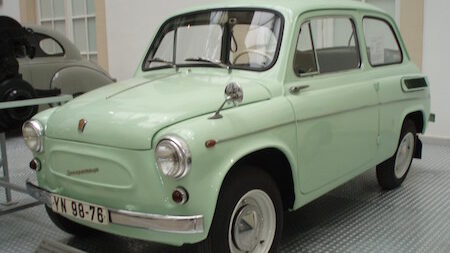In a country where only party bigwigs travelled in cars and for everyone else it was bus, train or Shanks’s pony, the advent of the Zaporozhets was nothing short of momentous.
The Zaporozhets was the nearest the USSR would get to creating its own Volkswagen and was the direct result of the liberal reforms undertaken by Premier Nikita Khruschev. After the harshness of the Stalin years, Khruschev placed more emphasis on people and on production of consumer goods rather than heavy machinery.
In its native Ukraine, Zaporozhets is the old word meaning Cossack and production began at the Zaporozhsky Automobile factory, ZAZ, in 1959. The original Zap, the 965, was a small, rounded car clearly copied from the Fiat 600. With a rear mounted 887cc air cooled engine, the ZAZ 965 was of simple, utilitarian construction designed to be as cheap as possible.
Indeed, Khruschev decreed that it was not to cost more than 1,200 roubles, which still represented years of savings for the average Boris or Ludmilla, but it meant that for a fortunate minority, having a car became a possibility.
The Zap had a V4 rather than flat four engine: this made the sparking plugs more accessible and the engine easier to work on, an important factor in a vast and undeveloped country where owners generally had to do their own maintenance. The straightforward torsion bar suspension was similarly serviceable and even if it tended to lose its tension, ride on Russia’s often unmade roads was at least tolerable. With barely 30bhp, lift off oversteer was unlikely to be encountered.
In 1967, a second model started to come off the line at ZAZ. This was the 966 and this time, much of the visual inspiration came from the Chevrolet Corvair, but the dimensions were virtually those of the boxy NSU Prinz, also an air cooled, rear engine design. Mechanically there were few changes from the 965, though the 966 had a separate petrol-fired heater, a slightly precarious device that Chevrolet had tried on the Corvair and Porsche offered on some rally specification 911s. The 966 also had a radio!
Later a 1200cc version emerged from the factory and with an 8.4:1 compression ratio said to produce a dizzying 50bhp on 93 octane petrol. As only 76 octane was generally available though, most cars were made with a lower compression ratio and the loss of about 6bhp.
During the 1970s, ZAZ cooperated with Renault and a number of cars was fitted with water cooled 956cc Renault units and Triplex windscreens and sold under the “Yalta” brand in France and Scandinavia; standard manufacture Zaps were exported in greater numbers to other communist bloc countries, particularly Hungary and Bulgaria which had no indigenous car production.
ZAZ built over 300,000 of the 965 model which stopped in 1969 and roughly double that figure for the 966, 7 & 8 (NSU-style) models. The Zaporozhets’s principal designer who was also the plant director, Yuri Sorochkin, wanted to extend the range much further into larger cars and also small trucks.
Until the end of communism, the USSR had a striking shortage of one ton utility vehicles and regular visitors would marvel at the way the Russians always seemed to need a ten ton truck just to deliver parcels or loaves of bread. It was a classic anomaly of state planning and characteristically it was to stymie Sorochkin’s plans, refusing him permission, despite successful prototypes, to build something on the lines of VW’s much admired van.
The air cooled Zaporozhets was always very basic transport, but it mobilized a section of Russian society much as the Model T Ford had in America fifty years before and for this, its owners were grateful. They tolerated the V4’s tendency to overheat in hot weather (the aluminium head and iron block were always uneasy bedfellows) and became adept at fixing their own breakdowns. “Zapor” in Russian also means constipation and made ZAZ cars the butt of endless jokes, but in the end it was infinitely preferable to taking the bus (if there even was one).
When the world turned and the Soviet Union disintegrated, state planning yielding to the open market and the Zap became a despised symbol of the mediocrity of the old regime. People cast them aside as soon as they could afford an imported car. ZAZ production itself was modernised, the Zap mutating into the Tavria, a clumsily slab sided front wheel drive hatchback which did not even bear the Zaporozhets name.

Now, twenty-five years after those upheavals and new generations of drivers too young to remember Soviet life, the Zaporozhets is viewed a rather differently. It has become something of a cult car, like the vastly inferior, indeed criminally awful Trabant; today there are Zaporozhets clubs of proud owners for whom the Zap is no longer contemptibly old fashioned, but a symbol of individuality, a status that the central planners would never have believed or still less understood!
© Image of Saporoshez ZAZ 965 A by Brams in Dresden museum
As a youngster he used to send race reports on Mallory Park meetings to the Derby Evening Telegraph which unaccountably always failed to print them. For thirty years he produced reports and analysis for other people before turning to motoring journalism and writing about matters rather closer to heart. An old 911, acquired when they were still affordable opened the world of Porsche and today he writes on historical subjects for several Porsche magazines in Europe and the US. He is also the UK correspondent for the classic car weekly, La Vie de l'Auto and keeps a foot in the modern world with a column in Trucking, a transport magazine, and as motoring correspondent for the Irish Police Journal.

